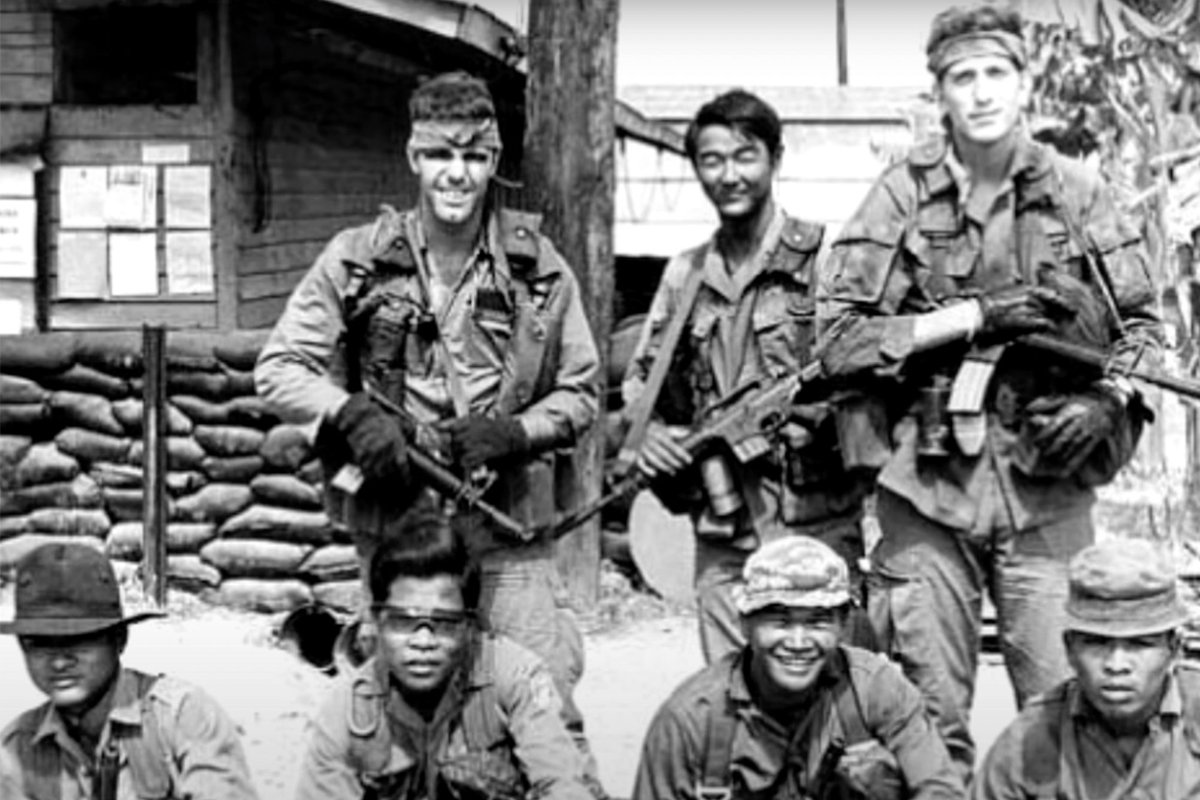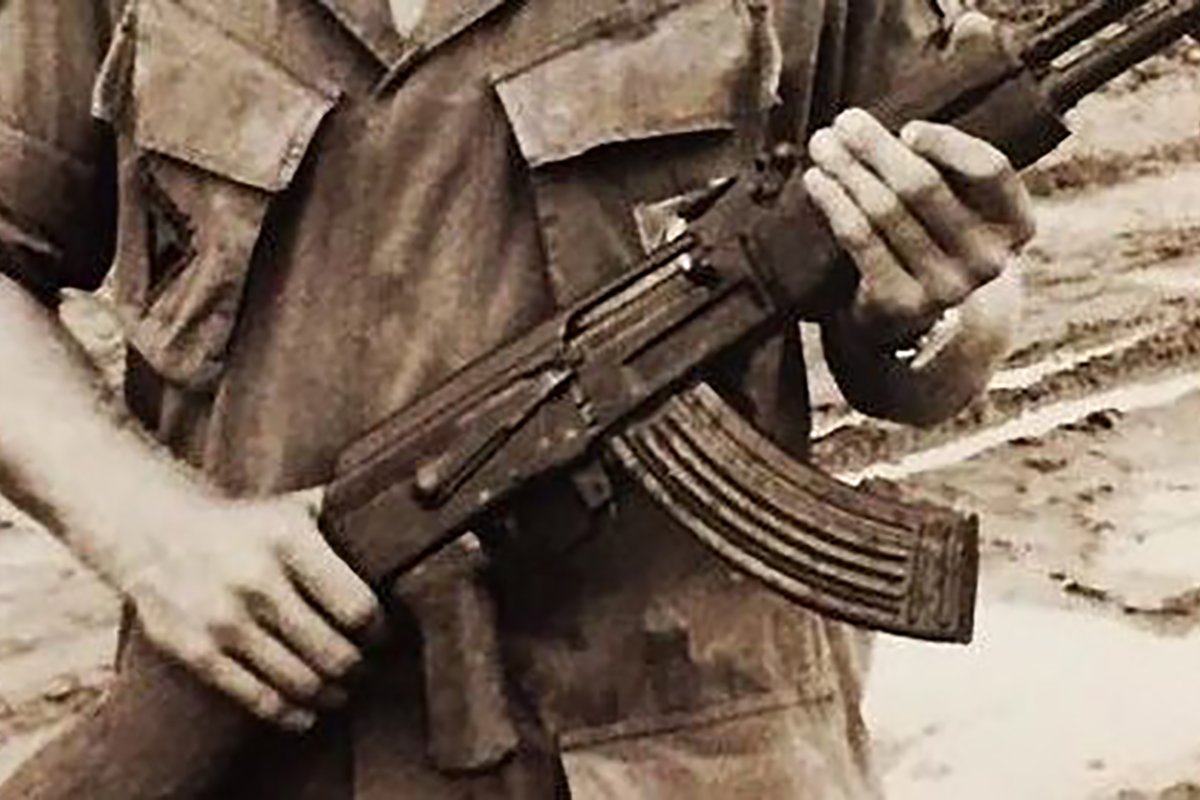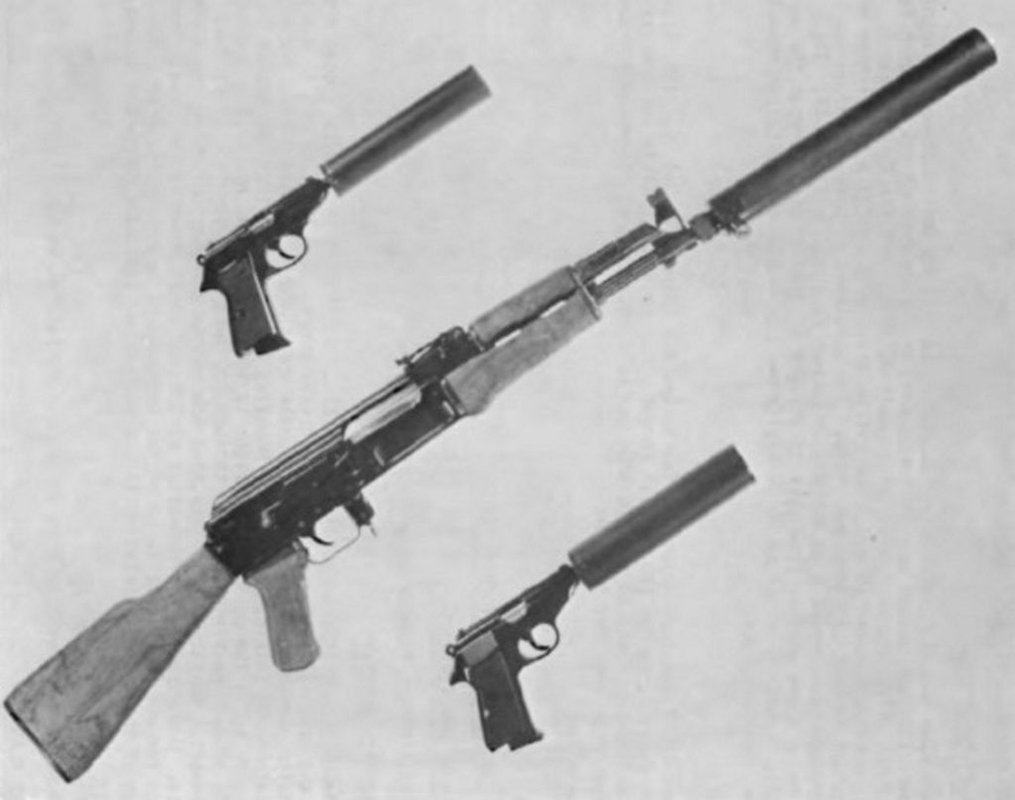
The shortened RPK was a lighter alternative to the M60. Photo courtesy of Sandboxx.
I love when military forces use something other than the same old standard issue kit. I like the what and the why of the situation–the mission sets, circumstances, and individuals who are forced to look outside the confines of the base armory for their loadout. The MACV-SOG weapons, like the very men in the elite and secretive unit, most certainly stand out.
The Military Assistance Command, Vietnam – Studies and Observations Group, or MACV-SOG, was one of the most secretive special operations groups in the world. MACV-SOG mixed a number of Special Operations forces and CIA men to form an elite team that could conduct special and black operations in places the United States could not acknowledge they were going at the time.

The Why Behind the MACV-SOG Weapons
To accomplish their incredibly dangerous and secretive missions, the men of MACV-SOG were armed with a variety of weird and unique weapons. One of the most significant reasons these special operators weren’t rocking the same firearms as the rest of the service was that the standard-issue weapons just didn’t fit many of their special mission profiles.
Perhaps most importantly, however, MACV-SOG conducted secret operations fighting North Vietnamese guerillas in Cambodia and Laos, both nations U.S. troops were not authorized to fight in. The weird MACV-SOG weapons gave the United States a degree of plausible deniability in the event things went wrong and the MACV-SOG commandos didn’t make it back.
Deception was also a critical factor in the survival of the MACV-SOG operators, and carrying indigenous weapon systems, or weapons that were capable of unusual and specific functions, sometimes aided in that effort.

The XM177 Commando
The XM177 is about as normal as MACV-SOG weapons got. It was a member of the CAR-15 and M16 families of rifles. The XM177 Commando was shortened variant of the M16 with a 10-inch barrel topped with a moderator and a collapsing stock. It was a 5.56 rifle that delivered compact firepower that outperformed any SMG in use at the time.
These unique weapons were the pioneers of the carbine assault rifle. Rifles in service today like the M4 and the Mk18 are descendants of this very platform. It was light and short, allowing MACV-SOG commandos to keep quick on their feet and maneuverable amid the difficult jungle warfare.

The Mk 22 Hushpuppy
The Mk 22 Hushpuppy was developed for the Navy for the SEAL teams, and along the way, some drifted to SOG. It’s a pretty easy path to trace, after all, a number of SEALs served in SOG teams. The Hushpuppy was a silenced, highly modified S&W Model 39 9mm pistol. It utilized a suppressor and featured suppressor height sights for improved accuracy. The Mk 22 used subsonic 9mm rounds that ensured everything stayed as quiet as possible.
The Mk 22 featured a locking device that prevented the slide from reciprocating. This allowed the gun to be insanely quiet. It was perfect for picking off enemy sentries and guard dogs without raising any alarms. It was the most silent of the MACV-SOG weapons, and as such, was favored when secrecy was paramount.

Swedish K
I’ve written about the Swedish K before, and in Vietnam, they were a favorite among CIA personnel. They were highly accurate, easy to control, and for the time, modern submachine guns (SMGs). The Swedish K was favored for a number of reasons, but chief among them was deniability. It was made in, you guessed it, Sweden–and a 9mm SMG from a neutral country does little to arouse suspicion about American troops. Add in an integrally suppressed barrel, and you have a light and sweet SMG for close-quarters fighting that was perfectly suited for MACV-S0G.
This is the only one of these unique weapons that the manufacturer eventually stopped selling due to moral outrage at the Vietnam war. The Swedes refused to sell arms to the United States to be used in the conflict. When in use, the Swedish K was an impressive gun, and SOG users carried over 450 rounds to keep the fight going. Sadly, like all pistol-caliber weapons, it lacked some efficiency, and short carbines replaced it relatively quickly for fighting men.

AKM
The AKM and Type 56 are AK 47 derivatives provided to Vietnamese forces by China and Russia. They were the main arm of the enemy, but MACV-SOG often carried them as well. You’ll often hear people claim they took them because the M16 series sucked, but in reality, MACV-SOG carried them to deceive the enemy.
The point man of a team could be carrying an AK and North Vietnamese gear and, if spotted, not instantly give the team away. Plus, in a firefight, the AK makes a distinct noise. As such, it could confuse the enemy about firing positions and force structure. Additionally, prior to the CAR-15, the AK offered more power than an SMG but was shorter than the M-16 or M14 family of rifles.

The Uzi
The Israeli Uzi was a brilliant weapon designed to arm Israeli soldiers. However, it wasn’t long before it became a famous export. MACV-SOG’s HALO (High Altitude Low Opening) parachute teams often carried the Uzi due to its compact design and lightweight nature. It could accept a detachable silencer and was very reliable. While most were made in Israel, the MACV-SOG weapons were made under license by FN Herstal, a Belgium firm.
Again, the Uzi added a degree of deniability to the SOG commandos. Obviously, like an SMG, it was limited in its range and power, but when you have to parachute from high altitude, you want something small. As far as unique weapons go, the Uzi is one of the more common firearms from around the world, making it easy to deny. Israel has sold over 2 billion dollars worth of Uzis since it was created in the 1950s.

Walther PPK
The Walther PPK is famed for its use by James Bond in numerous movies and books, but it also rolled with real black ops commandos in the MACV-SOG world. The Walther PPK was very small and fired the 380 ACP round. This round is subsonic by nature and with a suppressor, it’s a very quiet gun. This made it one of the earliest suppressed pistols used by Vietnam commandos and provided an off-the-shelf option before specially made weapons became available.
This little pistol allowed SOG commandos to dispatch their enemies quite silently. It was also small and lightweight, and these guys liked shaving weight, seeing as they had to carry everything they used through the jungle.

Cut Down RPD
These commandos loved having some serious firepower, but the machine gun of the time was quite heavy. The M60, aka the Pig, was a hefty beasty at over 23 pounds unloaded, as was the 7.62x51mm ammunition it needed. It worked, but they wanted something lighter, and they found it in captured RPD light machine guns. The RPD utilized the Soviet 7.62x39mm round and was a belt-fed gun that weighed only 16 pounds unloaded.
To make the RPD even lighter and handier, they trimmed the barrel down to the gas tube. This became one of the more unique MACV-SOG weapons in Vietnam. The RPD became less of a fire support weapon and more of an ambush and anti ambush weapon. It laid down the hate like the best of them, all while happening to sound just like enemy weapons. This helped create a cover for the sound of the RPD cooking off and helped the SOG teams stay disguised. As far as unique weapons go, this one takes the cake.

Browning High Power
MACV-SOG knew that a fighting handgun worked best with a higher capacity magazine and the Browning Hi-Power offered 13 rounds of 9mm in a world where eight rounds were standard. The Hi-power had already seen massive success in Western Europe and was a very potent fighting pistol with a proven history of success. While it was one of the MACV-SOG weapons, it was never an official US Army pistol.
Browning provided a modern sidearm for these commandos who truly needed it. The close-range fighting these men participated in made a sidearm a necessity. The Hi-Power might have been the very best option in the world at that point in time. For most of the world, this was a rather plain weapon, but for Americans, Hi-powers were unique.

V-40 Mini Grenades
Hand grenades are great, but they can be rather large and heavy. These mini grenades were the size of a golf ball and excelled for a variety of reasons. First, it’s easier to carry a ton of them. Accuracy through volume is a valid concept, and the V-40 provided the grenade version of that.
These mini frags were quite deadly, and when ambushed, they provided the ambushees with a lot of grenades to toss back as they fought through or escaped. The same goes for Recon teams breaking contact. They often rely on explosives and machine guns. The V40 Mini grenades also must’ve been the cutest way to blow stuff up most of these war fighters had ever seen.
Hitting Hard
MACV-SOG weapons were capable weapons that allowed these soldiers to accomplish their unique missions. These forces provided a clandestine edge to American forces in Vietnam. While these small arms were really a tiny part of the greater war, in the hands of the men of MACV-SOG, they could accomplish a great deal.
This article was originally published Oct. 7 on Sandboxx News. Follow Sandboxx News on Instagram.
Read Next: The Time a MACV-SOG Commando Took On a Force of 100 by Himself

Coffee or Die is Black Rifle Coffee Company’s online lifestyle magazine. Launched in June 2018, the magazine covers a variety of topics that generally focus on the people, places, or things that are interesting, entertaining, or informative to America’s coffee drinkers — often going to dangerous or austere locations to report those stories.
BRCC and Bad Moon Print Press team up for an exclusive, limited-edition T-shirt design!
BRCC partners with Team Room Design for an exclusive T-shirt release!
Thirty Seconds Out has partnered with BRCC for an exclusive shirt design invoking the God of Winter.
Lucas O'Hara of Grizzly Forge has teamed up with BRCC for a badass, exclusive Shirt Club T-shirt design featuring his most popular knife and tiomahawk.
Coffee or Die sits down with one of the graphic designers behind Black Rifle Coffee's signature look and vibe.
Biden will award the Medal of Honor to a Vietnam War Army helicopter pilot who risked his life to save a reconnaissance team from almost certain death.
Ever wonder how much Jack Mandaville would f*ck sh*t up if he went back in time? The American Revolution didn't even see him coming.
A nearly 200-year-old West Point time capsule that at first appeared to yield little more than dust contains hidden treasure, the US Military Academy said.












